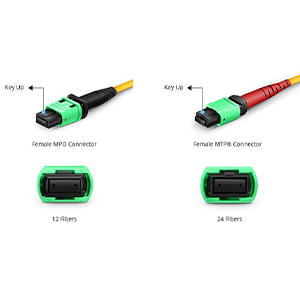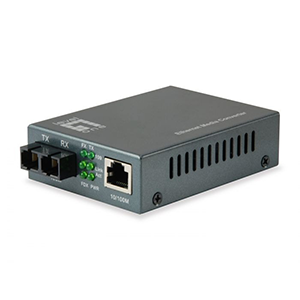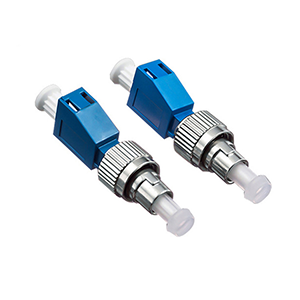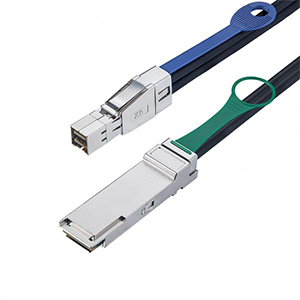Hello everyone! With the continuous development of optical fiber network technology, MPO and MTP optical fiber cables play an increasingly important role in realizing optical fiber network deployment due to their high density and easy connection. Today, gracyfiber is pleased to introduce to you in detail the characteristics of these two cables and their similarities and differences in practical applications. We hope to help you better understand and select appropriate optical fiber cables, and provide effective solutions for your network construction and upgrades. Value reference.
MPO fiber optic cable overview
Let me give you an overview of the basic characteristics and application scenarios of MPO (Multiber Push On) optical fiber cables:
Basic features of MPO cables:
- MPO cable is a multi-core fiber optic connector that accommodates multiple optical fibers in a single connector housing.
- Common MPO connectors are available in 12-core and 24-core specifications, which can support simultaneous transmission of multiple optical fibers.
- MPO connector adopts push-on installation method, which can be quickly connected and disconnected without tools.
- MPO cable has the characteristics of high density, easy installation, and reusability, and is suitable for scenarios that require large-capacity optical fiber transmission.
Common port configurations and application scenarios of MPO cables:
- MPO cables are usually used in high-density optical fiber deployment scenarios such as optical fiber backbone networks, data centers, and 5G base stations.
- MPO-MPO direct attach cables can be used to connect fiber optic trunks.
- MPO-LC or MPO-SC patch cords can be used to connect MPO trunks to single-fiber equipment.
- MPO cables can also be used to create pre-terminated fiber optic patch panels or splitter modules.
Advantages of MPO cables in high-density fiber deployment:
- A single MPO connector can accommodate multiple optical fibers, greatly improving interface density and space utilization.
- Push-pull installation method is simple and fast, convenient for rapid on-site deployment and maintenance.
- MPO cables are reusable and can reduce installation costs for fiber optic connections.
- MPO cables can support high-speed optical transmission to meet the expansion of future optical network capacity requirements.
In short, MPO fiber optic cable is a connection solution specially designed for high-density fiber deployment. It has many advantages and is widely used in optical network construction in telecommunications, data centers and other fields.
MTP fiber optic cable overview
Let me introduce to you the characteristics of MTP (Multifiber Termination Push-on) optical fiber cable and its relationship with MPO cable:
MTP cable features:
- MTP cable is a multi-core fiber optic connector technology similar to MPO cable.
- MTP connectors are typically used in 24- or 32-fiber high-density fiber optic transmission applications.
- MTP connector adopts Push-on installation method, which can be quickly connected and disconnected without tools.
- MTP connectors have better optical and mechanical properties and can provide better support for high-speed optical transmission.
The relationship and difference between MTP cables and MPO cables:
- Both MTP and MPO cables are multi-core optical fiber connection technologies, and their basic principles and application scenarios are similar.
- But MTP is an improved version of the MPO standard with higher optical performance and mechanical stability.
- MTP connectors are usually not interconnect-compatible with MPO connectors and require the use of special adapters or jumpers for transfer.
- In certain high-speed, high-density optical network applications, MTP cables can provide better transmission performance.
Unique advantages of MTP cables in certain application scenarios:
- In high-density fiber optic deployment in data centers, MTP cables can provide higher port density and transmission bandwidth.
- For applications requiring long-distance, high-speed optical transmission, such as 5G wireless base station backhaul, MTP cables can provide better transmission quality.
- In some applications that have strict requirements on the reliability and stability of fiber optic connections, the excellent mechanical properties of MTP cables can provide better support.
- Compared with MPO cables, MTP cables also perform better in certain special environments (such as high temperature and high humidity).
In short, MTP cable is an improved version of MPO cable and has unique advantages in certain high-density, high-speed optical network applications. However, the two can be used interchangeably in most scenarios, and the choice needs to be weighed based on specific application requirements.
Mutual compatibility of MPO and MTP cables
Let me introduce to you in detail the mutual compatibility of MPO and MTP fiber optic cables in terms of physical connections and what you need to pay attention to when using conversion cables:
Physical connection compatibility for MPO and MTP cables:
- There are some differences in the physical structure of MPO and MTP connectors, and the two are not compatible with direct connection.
- MPO connectors are usually available in 12-core and 24-core specifications, while MTP connectors are available in 24-core and 32-core specifications.
- Even though the number of cores is the same, the physical size and interface shape are slightly different between MPO and MTP connectors.
- Therefore, MPO and MTP cables cannot be connected directly, and special conversion cables or adapters are required.
Things to note when using MTP-MPO conversion cables:
- MTP-MPO conversion cables usually consist of an MTP connector on one end and an MPO connector on the other end.
- When using a conversion cable, you need to ensure that the number of cores and polarity (key) of the connectors at both ends match exactly.
- If the polarity does not match, it may cause errors in the mapping relationship of Fiber Channel.
- In addition, the optical performance of the conversion cable may also be slightly lost, thus affecting the overall transmission quality.
Recommendations for choosing MPO or MTP cables in different network environments:
- For general high-density fiber deployment applications, MPO cable is often the first choice because of its lower cost and wider availability.
- But for applications that require extremely high transmission performance and reliability, such as data center backbone or 5G wireless backhaul, MTP cables may provide better support.
- If there are both MPO and MTP devices in the network environment, you need to use an MTP-MPO conversion cable to connect. However, the conversion links should be reduced as much as possible to reduce performance loss.
- For future network planning and deployment, it is recommended to give priority to the use of MTP cables because it can provide better support for high-speed optical transmission.
From the above, it is easy to see that although there are some physical connection differences between MPO and MTP cables, the two connectors can still be compatible with each other through the use of specialized conversion cables. In practical applications, selection considerations need to be made based on specific network requirements.
What matters should be paid attention to in practical applications
Let me summarize some important things to note when using MPO and MTP cables in practical applications:
The importance of matching cable end face specifications:
- MPO and MTP cables have different end specifications, such as PC, APC, etc. It is necessary to ensure that the specifications at both ends match exactly.
- If the end face specifications do not match, it will seriously affect the transmission quality of optical signals and even cause communication failures.
- When purchasing and deploying MPO/MTP cables, be sure to carefully check the end face specifications at both ends to ensure full compatibility.
Other factors to consider:
- The number of cores of the cable: 12 cores, 24 cores or 32 cores, you need to choose the appropriate specifications according to the actual application scenario.
- Cable length: should be selected based on the actual wiring distance on site to avoid being too long or too short.
- Cable attributes: such as single-mode/multi-mode, low-smoke halogen-free, flame retardant, etc., need to be selected based on environmental requirements.
- Cable installation environment: For example, whether cables for use in special environments such as outdoor/high temperature/machine room are needed.
- Connector type: MPO, MTP or MPO-LC, MPO-SC and other combination types.
Best practices in different application scenarios:
- For general high-density fiber deployment, such as backbone links in computer rooms, MPO cables are usually the first choice.
- For applications that require higher transmission performance and reliability, such as data center core networks or 5G base station backhaul, MTP cables may be more suitable.
- In mixed application environments, MPO-MTP conversion cables are required for connection, but the conversion steps should be minimized.
- In future network planning, it is recommended to give priority to the use of MTP cables because it can provide better support for high-speed optical transmission.
- Whether you choose MPO or MTP, make sure that the cable’s end face specifications, number of cores, length and other parameters fully match the actual needs.
To sum up, when using MPO and MTP cables in actual applications, in addition to paying attention to the physical connection compatibility of the two, you also need to focus on end-face specification matching, cable parameter selection, and best practices in different scenarios. Only in this way can the reliability and transmission performance of the optical fiber connection solution be ensured.
Summary
MPO and MTP optical fiber cables, as important carriers for high-density optical fiber deployment, have some noteworthy differences and compatibility issues in their applications. MPO cables have a simpler fiber end face structure and are more advantageous in high-density wiring; while MTP cables show unique advantages in some special application scenarios.
In specific use, it is necessary to fully consider the matching of cable and fiber end face specifications, as well as the compatibility of cables and equipment interfaces, in order to ensure the stable operation of the optical fiber network. Our professional technical team is ready to provide you with a full range of MPO/MTP cable application support. If you have any questions during use, please feel free to contact us for communication.
Are MPO And MTP cable The Same FAQ
MPO (Multi-fiber Push-On) cables are fiber optic cables that use a multi-fiber connector with a rectangular shape, typically supporting 12 or 24 fiber optic strands.
MTP is a specific type of MPO connector and cable developed by US Conec. MTP cables are essentially a branded version of the MPO standard.
While MPO and MTP are not exactly the same, they are very similar. MTP is a specific implementation of the broader MPO standard, so all MTP cables are MPO, but not all MPO cables are MTP.
The primary difference is that MTP is a trademarked and proprietary version of the MPO standard, developed and licensed by US Conec. MTP cables may have slight design or performance differences compared to generic MPO cables.
Yes, in most cases MPO and MTP cables can be used interchangeably, as they use the same underlying multi-fiber connector design and are compatible with each other.
MTP cables are more widely used and recognized in the fiber optic networking industry, but MPO cables are also commonly used, especially in more generic or cost-sensitive applications.
While the performance differences are typically minor, MTP cables may have slightly better optical and mechanical specifications compared to generic MPO cables.
MPO and MTP cables are designed to work with equipment and transceivers that support the multi-fiber connector standard, regardless of whether they are branded as MPO or MTP.
You can typically identify an MPO or MTP cable by the distinctive rectangular-shaped multi-fiber connector. The connector may also be labeled with “MPO” or “MTP” to indicate the specific standard.
As long as the fiber count and polarity (male/female) match, MPO and MTP cables can generally be used interchangeably. However, it’s always best to consult the equipment manufacturer’s recommendations.





